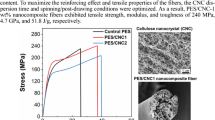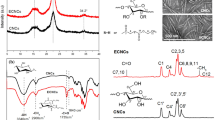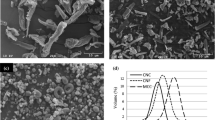Abstract
Bicomponent cellulose – polyacrylonitrile (PAN) core-shell fibers were produced using coaxial wet spinning. Varying the core-shell composition ratio resulted in changes in the morphology, mechanical and thermal properties of the fibers. When cellulose was the core polymer the fibers had irregular, circular cross-sectional morphology, with the PAN shell containing voids increasing in size from the shell towards the core. When PAN was utilized as the core, fibers showed a spiral core morphology and long, finger-shaped voids extended from the shell surface to the core-shell interface. The mechanical properties of the fibers exhibited double-fracture behavior, increased stiffness, and a reduction in plastic strain. The bicomponent fibers showed two decomposition temperatures, and the first decomposition temperature increased with cellulose acetate content. This work highlights the flexibility in properties that can be obtained via bicomponent wet spinning using polymers that are unable to be melt-processed.






Similar content being viewed by others
Availability of data and material
Please contact the corresponding author.
References
Haider TP, Völker C, Kramm J, Landfester K, Wurm FR (2019) Plastics of the future? The impact of biodegradable polymers on the environment and on society. Angew Chem Int Ed 58:50–62. https://doi.org/10.1002/anie.201805766
Hufenus R, Yan Y, Dauner M, Yao D, Kikutani T (2020) In: Hu J, Kumar B, Lu J (eds) Handbook of Fibrous Materials. Wiley-VCH, Weinheim. https://doi.org/10.1002/9783527342587.ch11
Mukhopadhyay S (2014) In: Zhang D (ed) Advances in filament yarn spinning of textiles and polymers. Woodhead Publishing, Oxford. https://doi.org/10.1533/9780857099174.2.113
Matsouka D, Vassiliadis SG (2018) In: Vassiliadis SG, Matsouka D (eds) piezoelectricity - organic and inorganic materials and applications. IntechOpen. https://doi.org/10.5772/intechopen.78389
Hufenus R, Gooneie A, Sebastian T, Simonetti P, Geiger A, Parida D, Bender K, Schäch G, Clemens F (2020) Antistatic fibers for high-visibility workwear: challenges of melt-spinning industrial fibers. Materials 13:2645. https://doi.org/10.3390/ma13112645
Liu W, Zhang J, Liu H (2019) Conductive bicomponent fibers containing polyaniline produced via side-by-side electrospinning. Polymers 11:954. https://doi.org/10.3390/polym11060954
Maqsood M, Seide G (2019) Novel bicomponent functional fibers with sheath/core configuration containing intumescent flame-retardants for textile applications. Materials 12:3095. https://doi.org/10.3390/ma12193095
Hufenus R, Affolter C, Camenzind M, Reifler FA (2013) Design and characterization of a bicomponent melt-spun fiber optimized for artificial turf applications. Macromol Mater Eng 298:653–663. https://doi.org/10.1002/mame.201200088
Gupta VB (1997). In Gupta VB, Kothari VK (eds) Manufactured Fibre Technology. Springer, Netherlands, Dordrecht, pp 124–138
Thomas B, Raj MC, Athira KB, Rubiyah MH, Joy J, Moores A, Drisko GL, Sanchez C (2018) Nanocellulose, a versatile green platform: from biosources to materials and their applications. Chem Rev 118:11575–11625. https://doi.org/10.1021/acs.chemrev.7b00627
Kotek R (2006) In: Lewin M (ed) Handbook of Fiber Chemistry, 3rd edn. Taylor & Francis Group
Karki HP, Kafle L, Ojha DP, Song JH, Kim HJ (2019) Cellulose/polyacrylonitrile electrospun composite fiber for effective separation of the surfactant-free oil-in-water mixture under a versatile condition. Sep Purif Technol 210:913–919. https://doi.org/10.1016/j.seppur.2018.08.053
Global Cellulose Fibre Market (2020) Expert market research, sheridan. https://www.expertmarketresearch.com/reports/cellulose-fibre-market. Accessed 22 Oct 2021
The Fiber Year (2021) The fiber year 2021: World survey on textiles & nonwovens. https://www.thefiberyear.com
Ma Y, Hummel M, Kontro I, Sixta H (2018) High performance man-made cellulosic fibres from recycled newsprint. Green Chem 20:160–169. https://doi.org/10.1039/C7GC02896B
Mahalingam S, Wu X, Edirisinghe M (2017) Evolution of self-generating porous microstructures in polyacrylonitrile-cellulose acetate blend fibres. Mater Des 134:259–271. https://doi.org/10.1016/j.matdes.2017.07.050
Kim H, Lee YJ, Lee SJ, Chung YS, Kim YY (2014) Fabrication of carbon papers using polyacrylonitrile fibers as a binder. Mater Sci 49:3831–3838. https://doi.org/10.1007/s10853-014-8096-4
Neisiany RE, Khorasani SN, Lee JKY, Ramakrishna S (2016) Encapsulation of epoxy and amine curing agent in PAN nanofibres by coaxial electrospinning for self-healing purposes. RSC Adv 6:70056–70063. https://doi.org/10.1039/C6RA06434E
Wang D, Yue Y, Wang Q, Cheng W, Han G (2020) Preparation of cellulose acetate-polyacrylonitrile composite nanofibers by multi-fluid mixing electrospinning method: Morphology, wettability, and mechanical properties. Appl Surf Sci. 510:145462. https://doi.org/10.1016/j.apsusc.2020.145462
Han CD, Segal L (1970) A study of fiber extrusion in wet spinning. II. Effects of spinning conditions on fiber formation. J Appl Polym Sci 14:2999–3019. https://doi.org/10.1002/app.1970.070141206
Radishevskii MB, Serkov AT (2005) Coagulation mechanism in wet spinning of fibres. Fibre Chem 37:266–271. https://doi.org/10.1007/s10692-005-0092-7
Naeimirad M, Zadhoush A, Kotek R, Neisiany RE, Khorasani SN, Ramakrishna S (2018) Recent advances in core/shell bicomponent fibers and nanofibers: A review. J Appl Polym Sci 135:46265. https://doi.org/10.1002/app.46265
Chen W, Su Y, Zheng L, Wang L, Jiang Z (2009) The improved oil/water separation performance of cellulose acetate-graft-polyacrylonitrile membranes. J Membr Sci 337:98–105. https://doi.org/10.1016/j.memsci.2009.03.029
Chang H, Luo J, Liu HC, Davijani AAB, Wang PH, Lolov GS, Dwyer RM, Kumar S (2017) Ductile polyacrylonitrile fibers with high cellulose nanocrystals loading. Polymer 122:332–339. https://doi.org/10.1016/j.polymer.2017.06.072
Shimizu M, Álvarez-Asencio R, Nordgren N, Uedono A (2020) Preparation and characterization of cellulose acetate membranes with TEMPO-oxidized cellulose nanofibrils containing alkyl ammonium carboxylates. Cellulose 27:1357–1365. https://doi.org/10.1007/s10570-019-02872-5
Frihart CR (2013) In: Rowell RM (ed) Handbook of Wood Chemistry and Wood Composites, 2nd edn. CRC Press, Florida
Shi XQ, Ito H, Kikutani T (2006) Structure development and properties of high-speed melt spun poly(butylene terephthalate)/poly(butylene adipate-co-terephthalate) bicomponent fibers. Polymer 47:611–616. https://doi.org/10.1016/j.polymer.2005.11.051
Acknowledgments
The authors acknowledge the Australian Government for their support through an Australian Government Research Training Program Scholarship and acknowledge that this work was performed in part at the Deakin Hub in the Victorian Node of the Australian National Fabrication Facility (ANFF).
Funding
Funding for the project was provided through an Australian Government Research Training Program Scholarship.
Author information
Authors and Affiliations
Contributions
Conceptualization: Nolene Byrne and Lucas Rosson; Methodology: Nolene Byrne and Lucas Rosson; Formal analysis and investigation: Lucas Rosson; Writing - original draft preparation: Lucas Rosson; Writing - review and editing: Nolene Byrne and Lucas Rosson; Funding acquisition: Nolene Byrne; Resources: Nolene Byrne and Lucas Rosson; Supervision: Nolene Byrne.
Corresponding author
Ethics declarations
Ethics approval
Not applicable.
Consent to participate
Not applicable.
Consent for publication
Not applicable.
Conflicts of interest
The Authors confirm that there are no conflicts of interest.
Additional information
Publisher's Note
Springer Nature remains neutral with regard to jurisdictional claims in published maps and institutional affiliations.
Rights and permissions
About this article
Cite this article
Rosson, L., Byrne, N. Influence of core-shell composition ratio on morphology and mechanical properties for wet-spun bicomponent cellulose acetate-polyacrylonitrile fibers. J Polym Res 28, 484 (2021). https://doi.org/10.1007/s10965-021-02828-z
Received:
Accepted:
Published:
DOI: https://doi.org/10.1007/s10965-021-02828-z




